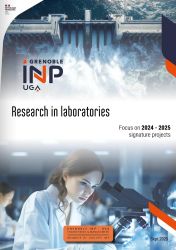As Pierre Benech, director of Grenoble INP - Phelma, explains: In a nuclear environment, damage mechanisms begin at the atomic scale with the onset of irradiation defects, with consequences at the macroscopic level: weakening of structures, corrosion caused by high temperatures, etc. These mechanisms are modelled and numerically simulated from the atomic scale to the macroscopic. At Grenoble INP, this work is performed in close collaboration with CEA and EDF. Experimental studies in the field of thermally aged microstructures, and oxidation or corrosion problems, are also performed in the institution's various laboratories that specialise in materials science. They are absolutely essential for extending the life of reactors and optimising the use of fuel, the transportation of used fuel and the storage of nuclear waste.
The materials for future reactors
Among the areas being explored for future reactors, scientists intend to develop reactors that operate at high or very high temperatures to increase energy efficiency and consume less fuel for the same amount of energy produced. This option requires extensive research on the materials to ensure that they are highly heat resistant. Ceramics, which are very resistant to heat, are an interesting option but have the disadvantage of being very fragile. Teams from SIMaP (Materials and Processes Science and Engineering Laboratory) are trying to improve their mechanical properties so that they are consistent with use in reactors. The scientific challenge is considerable.
The materials for future reactors
Among the areas being explored for future reactors, scientists intend to develop reactors that operate at high or very high temperatures to increase energy efficiency and consume less fuel for the same amount of energy produced. This option requires extensive research on the materials to ensure that they are highly heat resistant. Ceramics, which are very resistant to heat, are an interesting option but have the disadvantage of being very fragile. Teams from SIMaP (Materials and Processes Science and Engineering Laboratory) are trying to improve their mechanical properties so that they are consistent with use in reactors. The scientific challenge is considerable.
SUMMARY
- Editorial : Jobs for at least 40 years!
- Preparing for the future of the nuclear industry
- The nuclear industry also needs more general profiles
- Why train engineers in nuclear energy?
- A promising future for professions in the nuclear sector
- Thorium: the green future for nuclear power?
- IFCEN: a project in support of the French nuclear industry
- The importance of materials in the nuclear sector
- First-hand account from Boris Supiot, an engineer at AREVA
- Millennium interview: Nearly 50% of the workforce needs to be replaced





